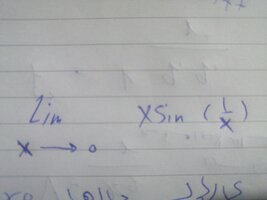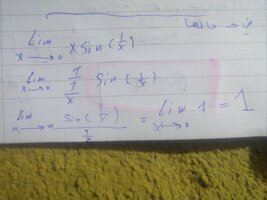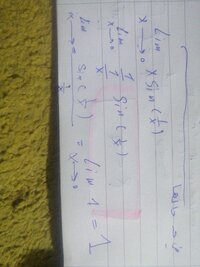You are using an out of date browser. It may not display this or other websites correctly.
You should upgrade or use an alternative browser.
You should upgrade or use an alternative browser.
Limit.. Zero or one?
- Thread starter Nwr
- Start date
pka
Elite Member
- Joined
- Jan 29, 2005
- Messages
- 11,976
Please post a complete readable of a statement of the problem as well as your work.Calcouls book solved it zero but i solve it one.. Where is the wrong step that i did?
Do not post an unreadable image. Thank you.
Steven G
Elite Member
- Joined
- Dec 30, 2014
- Messages
- 14,561
Sin(x) (or even sin(1/x)) is ALWAYS between -1 and 1. Well, sin(1/x) is undefined but that doesn't matter as x approaches 0 so it will never be 0
Consider the last inequality (assume x is not 0) -1< sin(1/x) < 1. Multiplying by x>0 we get -x< xsin(1/x) < x. What does the squeeze theorem tell you when x approaches 0+.
Now you consider what happens when x<0.
Consider the last inequality (assume x is not 0) -1< sin(1/x) < 1. Multiplying by x>0 we get -x< xsin(1/x) < x. What does the squeeze theorem tell you when x approaches 0+.
Now you consider what happens when x<0.
Harry_the_cat
Elite Member
- Joined
- Mar 16, 2016
- Messages
- 3,760
We can't help you if we can't read it!!
Steven G
Elite Member
- Joined
- Dec 30, 2014
- Messages
- 14,561


If x was going to infinity, then the answer would be 1.
Yes, lim x->0 (sinx/x) =1. Note that the angle x and the denominator are the same AND as x->0 the angle and the denominator also go to 0.
For example: lim as x->5 sin(x-5)/(x-5) = 1 since the angle and the denominator are the same and as x->5, (x-5)->0
In your problem lim x->0 sin(1/x)/(1/x) you do have the angle and the denominator being the same BUT as x->0, 1/x is NOT going to 0--it's going to infinity!!!!
You also replaced sin(1/x)/(1/x) with 1 in your work which is not true. Even sinx/x is not 1. Remember that a fraction is 1 when the numerator and denominator are the same! sinx is always between -1 and 1 while x can be any value. Consider sin(7)/7. This can't be 1 since sin(7) and 7 are not equal!! It is the lim x->0 sinx/x which equals 1.
Harry_the_cat
Elite Member
- Joined
- Mar 16, 2016
- Messages
- 3,760
Forget about your limit rules and think about what is going on.
\(\displaystyle -1\leq sin (\theta)\leq 1\) for all values of \(\displaystyle \theta\).
So, \(\displaystyle -1\leq sin (1/x)\leq 1\).
Now look at \(\displaystyle x\times \sin(\frac{1}{x})\).
If \(\displaystyle x\to 0\) then you have a value getting closer and closer to 0 multiplied by a value that lies between -1 and 1.
eg
\(\displaystyle 0.00001 \times \)(a number between -1 and 1).
\(\displaystyle 0.00000000001\times \)(a number between -1 and 1), etc.
Surely this is approaching 0.
\(\displaystyle -1\leq sin (\theta)\leq 1\) for all values of \(\displaystyle \theta\).
So, \(\displaystyle -1\leq sin (1/x)\leq 1\).
Now look at \(\displaystyle x\times \sin(\frac{1}{x})\).
If \(\displaystyle x\to 0\) then you have a value getting closer and closer to 0 multiplied by a value that lies between -1 and 1.
eg
\(\displaystyle 0.00001 \times \)(a number between -1 and 1).
\(\displaystyle 0.00000000001\times \)(a number between -1 and 1), etc.
Surely this is approaching 0.
Steven G
Elite Member
- Joined
- Dec 30, 2014
- Messages
- 14,561
I posted that information 1st!!Forget about your limit rules and think about what is going on.
\(\displaystyle -1\leq sin (\theta)\leq 1\) for all values of \(\displaystyle \theta\).
So, \(\displaystyle -1\leq sin (1/x)\leq 1\).
Now look at \(\displaystyle x\times \sin(\frac{1}{x})\).
If \(\displaystyle x\to 0\) then you have a value getting closer and closer to 0 multiplied by a value that lies between -1 and 1.
eg
\(\displaystyle 0.00001 \times \)(a number between -1 and 1).
\(\displaystyle 0.00000000001\times \)(a number between -1 and 1), etc.
Surely this is approaching 0.
Harry_the_cat
Elite Member
- Joined
- Mar 16, 2016
- Messages
- 3,760
Yeah yeah!! Just wait while I look for my gold stars.I posted that information 1st!!


